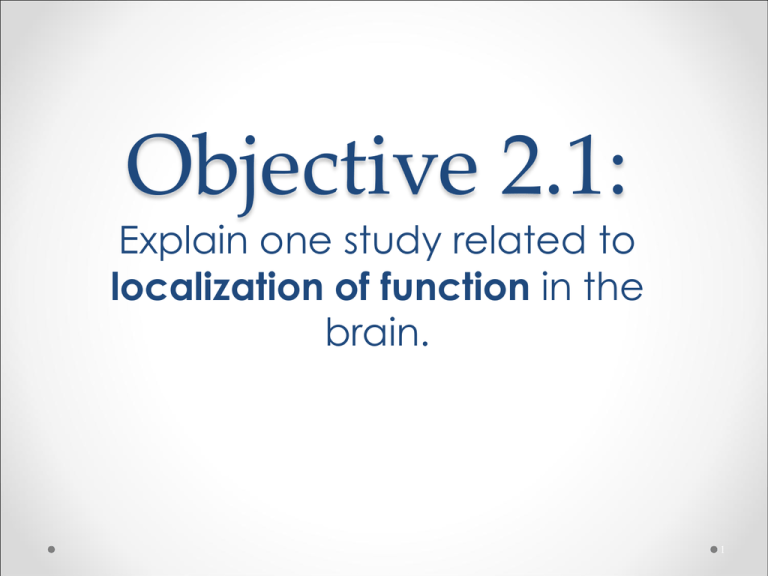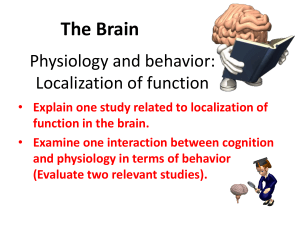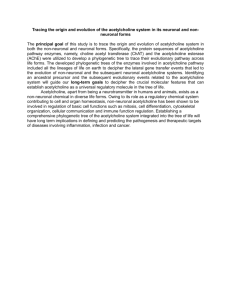File
advertisement

Objective 2.1: Explain one study related to localization of function in the brain. 1 Things to consider…. • Localization of function - The principle that specific functions have relatively circumscribed locations in some particular part of the brain. • Multiple studies (Broca’s study, Wernicke’s study, The case study of HM, The case study of Phineas Gage) can be used to explain localization of function in the brain. • Contemporary studies (Hull & Vaid, 2006) vastly differentiate from older studies (Sperry, 1968) in aim and participants. • The study that is chosen MUST be explained in detail. Example: aim, method, results, implications/relevance to L.O.F. 2 Localization in the Brain The first quarter of the nineteenth century witnessed a growth of interest in the localization of functions in the brain. Most neuroscientists would agree that the foundations of modern neuropsychology and cognitive neuroscience were laid by the French surgeon, anatomist and anthropologist, Paul Broca, in the 1860s. 3 Localization in the Brain At that time, Broca and his colleagues in Paris were discussing a lingering claim that language functions were located in the frontal lobes of the brain (Gall and Spurtzheim, 1809; Clarke and O’Malley, 1968; Schiller, 1992; Monod-Broca, 2005). 4 Localization in the Brain Amidst these discussions, Broca was consulted about a 51-year-old patient who was nicknamed “Tan” with multiple neurological problems, who had been without any productive speech for many years. Every time “Tan” attempted to utter a phrase or respond to a question, he could only produce a single repetitive syllable, ‘tan’. 5 Localization in the Brain He could vary the intonation of the sound but was not able to produce any recognizable words or phrases. Broca saw Tan's lack of speech as a test case for the question of language localization in the frontal lobes, since the patient clearly had no productive language. 6 Localization in the Brain Tan died of his ailments several days later and, using post-mortem methods, a lesion was found on the surface of the left temporal lobe as Broca had suspected. He presented his finding to the Anthropological Society (Broca, 1861) where some of the earlier discussions had taken place, and to the more established Anatomical Society of Paris (Broca, 1861) several months later. 7 Localization in the Brain The finding was met with enthusiasm and taken as support for the premise that cognitive functions could be localized to specific parts of the brain. 8 Lelong • Broca encountered a second patient named Lelong(age 84) who also exhibited reduced productive speech as the result of a stroke 1 year before • Could say only five words: o ‘oui’ (‘yes’) o ‘non’ (‘no’) o ‘tois’(a mispronunciation of ‘trois’ (‘three’) which he used to represent any number) o ‘toujours’ (‘always’) o ‘Lelo’(a mispronunciation of his own name). • His autopsy showed a lesion in approximately the same region of the lateral temporal lobe as the Tan o Broca reported it to the Anatomical Society as an important case, confirming the localization of speech to this area. The Facts • Modern lesion studies have found that Broca’s aphasia is caused by large lesions encompassing not necessarily Broca’s area, but surrounding frontal cortex, underlying white matter, the insula, basal ganglia and parts of the anterior superior-temporal gyrus. (e.g. Mohr, 1976; Mohr et al., 1978; Naeser and Hayward, 1978; Kertesz et al., 1979; Schiff et al., 1983; Basso et al., 1985; Murdoch et al., 1986; Alexander et al., 1990) Example Lesions The Evidence Doesn’t Lie • 3D MRI images of Tan’s brain have been made over the years. o The extent of the damage is obvious when comparing the sizes of the two hemispheres on the MRI images. The left hemisphere, as measured from the midline to the lateral surface, is up to 50% smaller than the right hemisphere. *MRI images allow us to see an anatomical view of the brain -> Localization in the Brain Although one single case would not be enough to conclude that specific parts of the brain are responsible for specific behaviors, Broca’s research laid the foundation for many research hypotheses that investigated specific parts of the brain correlating to specific behaviors. 13 Objective 2.2: Using one or more examples, explain effects of neurotransmission on human behavior. 14 Things to consider…. Multiple studies have suggested that neurotransmission plays a significant role in behavior. Research should be used to support your explanation of the effects of neurotransmission on behavior. 15 Review What do we already know about the role of neurotransmission and behavior? 16 Looking back… • Our chemical balances/imbalances correlate to specific human behaviors • Higher or lower levels of certain hormones and/or neurotransmitters can lead to changes in behavior. 17 Neurotransmission and behavior Neurotransmitters are produced and stored in the brain cells (neurons), and are released into action when neurons are electrically activated. Neurotransmitters play a large role in every thought, mood, pain and pleasure sensation that we feel. They control our energy level, appetite and what foods we crave. Neurotransmitters regulate how well we sleep and even our cognition. 18 Neurotransmission and behavior The brain is composed of billions of branching treelike nerve cells called neurons. They stretch out but never actually touch each other. How do the cells communicate with each other? 19 Neurotransmission Neurotransmission also called synaptic transmission, is the process by which neurotransmitters are released by a neuron (the presynaptic neuron), and bind to and activate the receptors of another neuron (the postsynaptic neuron). 20 Synaptic Communication Through a highly regulated electrochemical chain of events, the brain uses neurotransmitters to communicate with both itself and other organs and tissues in the body. Thus, Information is transmitted, neuron to neuron, from one area of the brain or body to another. 21 Synaptic Communication When this information eventually reaches its final destination, the message is translated into the contraction of a muscle, a emotion, a memory, etc. Of course, this is a highly simplistic version of the actual process. 22 How important is neurotransmission? • • Proper amounts of neurotransmitters are necessary for maintaining optimal mental and physical health. Some of the most significant clinical issues linked to neurotransmitter imbalances are: anxiousness, appetite control, attention issues, developmental delays, behavioral problems, low mood, fatigue, mood disorders, sleep disorders, weight issues, and many more. 23 Examples of Neurotransmitters responsible for behavior Dopamine: Thinking & Decision-making Higher levels: Assist with problem-solving, Able to generalize situations, Lowers impulsive behavior. Lower levels: Impulsive behavior, Irrational thinking. Norepinephrine: Alertness, Ability to focus attention Higher levels: Anxious, Hyper-alert, Paranoid Lower levels: Lethargy, Low energy, Depression Epinephrine: provide immediate strength and single-focused concentration for “Flight or Fight” reflex. Higher levels: Overstimulation of all mental and physical functions, Manic behavior Lower levels : Lethargy, Low energy, Depression 24 Important note • Please note that these associations are merely correlations, and do not necessarily demonstrate any cause and effect relationship. • We don’t know what other variables may be affecting both the neurotransmitter and the mental illness, and we don’t know if the change in the neurotransmitter causes the illness, or the illness causes the change in the neurotransmitter. 25 Acetylcholine • Acetylcholine is important for memory and learning and is a neurotransmitter used throughout the body. It controls muscle contraction for example. • Acetylcholine may be extremely important for short term memory. It determines your brain speed. If you have too little, your brain is going to slow down. This will play a role in reaction time, cognitive retention, and alertness. 26 Review of Acetylcholine • Psychologists Martinez and Kesner (1991) aimed to investigate the role acetylcholine in memory function. • Procedure: Experimental study using rats. They were trained to run a maze. They were divided into 3 groups. 27 Review of Acetylcholine • The study shows that acetylcholine is important in memory since the rats showed different memory capacity as a result of the level of the neurotransmitter acetylcholine. • Since the work was a controlled lab experiment, it can be concluded that levels of acetylcholine play a role in memory (but the neurobiology of memory is very complex). 28 Acetylcholine • You can think of acetylcholine as a lubricant for your brain and body. • Acetylcholine along with dopamine are the neurotransmitters that allow it to work hard and fast. • A lack of either one can lead to memory and attention problems. 29 Acetylcholine • Acetylcholine deficiency can display as Alzheimer’s, Multiple Sclerosis, dementia, dry mouth, dry skin, reading/writing disorders, speech problems, slow movement, mood swings, learning disorders, verbal memory problems, memory lapses, attention problems, difficulty concentrating, carelessness, and decreased creativity. • Many medications that fight the onset of these disorder provides the body with the amino acid that increase acetylcholine levels in brain. 30 Natural ways of increasing acetylcholine • Egg yolk • Cod, salmon, or tilapia • Shrimp • Soy protein • Peanut butter • Oat bran • Almonds • Hazelnuts • Macadamia nuts • Broccoli • Brussels sprouts • Cucumber, zucchini, lettuce • Skim milk • Trimmed ham • Low-fat cheese • Low-fat yogurt 31 Review of Acetylcholine • Although neurotransmission is only correlated with behaviors (as previously stated), Psychologist do not deny the significant role that neurotransmitters play in behavior. 32 Objective 2.3: Using one or more examples, explain functions of two hormones in human behavior. 33 Things to consider…. Multiple studies have suggested that hormones are not necessarily the only factor explaining human behavior. More research must be done to understand the extent to which hormones can truly effect behavior in humans without the contribution of multidirectional models. This is important to note before you assume that hormone A causes behavior B. Research should be used to support your explanation of the effects of neurotransmission on behavior. 34 Hormones and behavior connections Our bodies are designed in such a manner that they will function to their fullest with the right proportions and mix of hormones. Hormones are chemicals secreted from specialized cells into the bloodstream, from where they are transported to various parts of the body to act on target tissues, thereby producing physical and mental effects in an individual. They are secreted by various glands in the body such as thyroid gland, pituitary gland, pineal gland, pancreas, adrenal gland, parathyroid glands and gonads. Each hormone secreted by these glands have a specific set of functions. 35 “The Stress Hormone” • Cortisol (hydrocortisone) is a steroid hormone, or glucocorticoid, produced by the adrenal gland. It is released in response to stress and a low level of blood glucocorticoids. • Although stress isn’t the only reason that cortisol is secreted into the bloodstream, it has been termed “the stress hormone” because it’s also secreted in higher levels during the body’s ‘fight or flight’ response to stress, and is responsible for several stress-related changes in the body. 36 “The Stress Hormone” Small increases of cortisol have some positive effects: •A quick burst of energy for survival reasons •Heightened memory functions •A burst of increased immunity •Lower sensitivity to pain •Helps maintain homeostasis in the body 37 “The Stress Hormone” • Cortisol secretion varies among individuals. People are biologically ‘wired’ to react differently to stress. One person may secrete higher levels of cortisol than another in the same situation. This is why some people perceive things as being stressful when others do not. • Studies have also shown that people who secrete higher levels of cortisol in response to stress also tend to eat more food, and food that is higher in carbohydrates than people who secrete less cortisol. 38 “The Stress Hormone” • Excessive cortisol frequently causes increased fatigue/decreased energy, irritability, impaired memory, depressed mood, decreased libido, insomnia, anxiety, impaired concentration, crying, restlessness, social withdrawal and feelings of hopelessness. For more info: http://www.physorg.com/news/2011-02-behavioralproblems-linked-cortisol.html 39 Oxytocin and behavior Oxytocin regulates social affiliation and social recognition in many species and modulates anxiety, mood and aggression. The hormone is released during labor and remains abundant throughout the weening period. It is believed to stimulate the bonding receptors between the mother and child. Oxytocin is also released when physical contact is made and sends a soothing message throughout our body triggering an instinctual trust. 40 “The love hormone” The neuropeptide oxytocin (OXT) is currently attracting considerable attention as a result of the discovery of the amazing behavioral functions it regulates, especially in the context of social interactions. A broad variety of behaviors, including maternal care and aggression, pair bonding, sexual behavior, and social memory and support, as well as anxiety-related behavior and stress coping, are modulated by brain OXT (Neuman, 2008). This hypothesis is substantiated by the finding that intranasal OXT makes humans more trusting (Neuman, 2008) . Moreover, reduced levels of anxiety to psychosocial stress were described in subjects treated with intranasal OXT and receiving social support. For more info: http://www.ahealthymind.org/library/brain%20oxytocin.pdf 41











